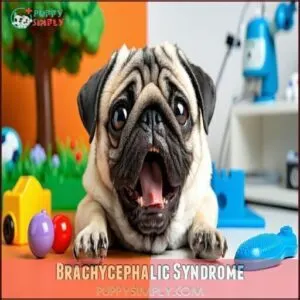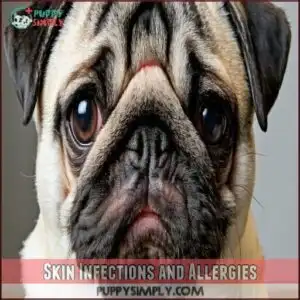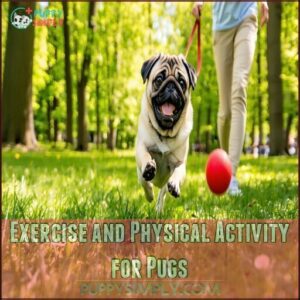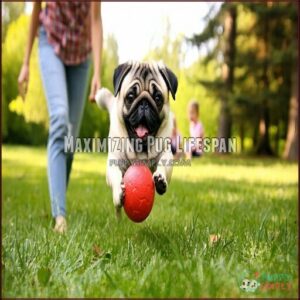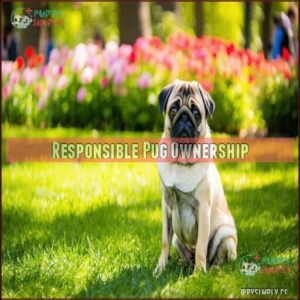This site is supported by our readers. We may earn a commission, at no cost to you, if you purchase through links.
 Your pug’s life span typically ranges from 12-15 years, though many wrinkly companions reach their late teens with proper care.
Your pug’s life span typically ranges from 12-15 years, though many wrinkly companions reach their late teens with proper care.
These squishy-faced friends face unique health challenges due to their flat faces and compact bodies.
You’ll need to manage their weight carefully, as pudgy pugs often face shortened lives.
Regular vet check-ups, proper dental care, and moderate exercise suited to their breathing limitations all contribute to a longer, healthier life.
Those cute snorts might charm you, but they can signal respiratory issues that need attention, and understanding the specific needs of these little bundles of personality makes all the difference in their golden years.
Table Of Contents
- Key Takeaways
- Pug Life Expectancy
- Pug Health Issues
- Pug Care and Nutrition
- Pug Life Stages
- Maximizing Pug Lifespan
- Responsible Pug Ownership
- Frequently Asked Questions (FAQs)
- What is the main cause of death in Pugs?
- Can a Pug live 20 years?
- At what age do Pugs start having health problems?
- Is 7 old for a Pug?
- What is the expected life expectancy of a pug?
- What is the average life span of a pug?
- What is the lifespan of a pug?
- What is the average lifespan of a pug/boxer mix?
- What is the leading cause of death in Pugs?
- Can Pugs live up to 20 years?
- Conclusion
Key Takeaways
- Your pug will typically live 12-15 years, with females often outliving males (13.2 vs 12.8 years), though proper care can help them reach their late teens.
- You’ll need to manage weight carefully as pugs are three times more likely to become obese than other breeds, which significantly reduces their lifespan.
- You should monitor for brachycephalic syndrome (breathing difficulties), eye problems, and skin fold infections—the most common health issues that can shorten your pug’s life.
- You can extend your pug’s lifespan through regular vet check-ups, proper nutrition, appropriate exercise (15-20 minute walks twice daily), and mental stimulation.
Pug Life Expectancy
Your pug can enjoy a healthy life of 12-15 years if you’re attentive to their specific health needs.
With the right care, your pug can thrive for 12-15 joyful years, full of love, snorts, and wagging tails.
Female pugs typically live slightly longer than males, with averages of 13.2 and 12.8 years respectively, though proper care and early detection of health issues can help your wrinkly companion reach the upper end of this range, with healthy life being the ultimate goal.
Average Lifespan of Pugs
Most pugs live between 12-15 years, with females typically outliving males (13.2 vs 12.8 years on average).
While that’s better than the general dog average of 10-13 years, historical data shows some pugs reaching their late teens.
Breed comparisons indicate pugs have decent longevity despite their health challenges. Converting pug years to human years, your wrinkly friend’s middle age starts around 7-8 years, which is a significant milestone.
Factors Affecting Pug Lifespan
While we’ve seen that pugs typically live 12-15 years, several key factors can either extend or shorten this timeframe.
Your pug’s lifespan is heavily influenced by genetics, diet quality, regular exercise habits, access to veterinary care, and their living environment.
Preventative measures like weight management and routine health screenings can help your furry friend avoid common pug health issues and maximize their life expectancy.
Many owners find that consistent vet care is especially helpful to improve life expectancy and ensure overall health screenings.
Genetics and Breeding History
The genetic makeup of your pug traces back over 2,000 years, with Ancient Origins in Chinese imperial courts.
Your pug’s lifespan is deeply influenced by its breeding history.
Five key factors in pug lineage that impact longevity:
- Selective breeding for flat faces caused breathing issues
- Limited Genetic Diversity increases health risks
- Historical inbreeding coefficients exceed many other breeds
- Responsible Breeding practices can reduce hereditary problems
- Breed Standards have evolved since the 1800s, shifting toward shorter muzzles
The key factors listed above highlight the importance of understanding the genetic and historical context of your pug’s lineage to ensure a healthier and longer life for your pet.
Pug Health Issues
Your pug’s flat face and compact build can lead to serious health issues that reduce their 12-15 year lifespan if you don’t take proper precautions.
You’ll need to monitor for breathing difficulties, weight gain, eye problems, and skin infections to guarantee your wrinkly companion stays healthy throughout their life.
Brachycephalic Syndrome
Now that you understand the average pug lifespan, let’s talk about a major challenge that can cut those years short.
Brachycephalic syndrome affects most flat-faced dogs, including your pug. Those adorable snorts aren’t cute—they’re warning signs of breathing difficulties.
This condition involves narrowed nostrils, elongated soft palates, and other structural issues that create BOAS (Brachycephalic Obstructive Airway Syndrome).
Your pug’s respiratory problems can lead to exercise intolerance and potentially require surgical options, which carry anesthesia risks.
Obesity and Weight Management
Nearly three times more likely to become obese than other breeds, your pug’s weight directly impacts their lifespan.
Portion control is essential—measure food carefully and limit treats to 10% of daily calories. Try healthy treat alternatives like carrots or green beans.
Exercise motivation may require creativity, but gentle daily activity protects joint health. Regular weight monitoring helps you catch changes early, keeping your pug at a healthy weight for years to come.
Consider exploring options for effective pug diets to maintain their ideal weight and ensure a long, healthy life with your pug, through effective management.
Eye Problems and Vision Care
Your pug’s bulging eyes aren’t just adorable—they’re vulnerable to serious health problems. Corneal ulcers, progressive retinal atrophy, and ocular proptosis (eye displacement) commonly affect pugs due to their facial structure.
Daily cleaning around the eyes prevents infections, while regular vet checkups catch cataracts early.
Dry eye treatments and protective measures during play can save your pug’s vision and contribute to their overall lifespan. A quality pug eye cleaner can help maintain hygiene.
Don’t ignore eye abnormalities—they’re essential to address, as they can lead to significant issues if not properly managed, emphasizing the importance of regular care.
Skin Infections and Allergies
While your pug’s eyes need protection, their skin demands equal attention.
Those adorable wrinkles aren’t just cute—they’re hotspots for trouble. Pugs face 5.9 times higher risk of skin allergies than other breeds, with fold hygiene being essential to prevent infections.
Regular cleaning of skin folds prevents bacteria buildup, while monitoring for unusual growths helps catch potential tumors early.
Demodicosis risks and mange susceptibility make pugs the "poster child" for skin disorders, highlighting the importance of skin allergies in their health.
Pug Care and Nutrition
You’ll substantially extend your pug’s 12-15 year lifespan by providing proper nutrition and daily care suited to their unique brachycephalic needs.
Your attention to balanced meals, appropriate exercise, and regular grooming of those adorable wrinkles will help prevent the common health issues that often cut short the lives of these charming companions, allowing you to enjoy a longer and healthier life with your pug.
Diet and Nutrition for Pug Dogs
Through proper diet and nutrition, your pug can maintain an ideal weight and live a longer, healthier life.
Feeding your pug high-quality food is vital for maximizing their 12-15 year lifespan.
A balanced diet, including essential vitamins and minerals, is needed for bone health and a strong immune system.
- Monitor portion control to prevent obesity, the #1 preventable health issue in pugs
- Check for food allergies which can cause skin issues and discomfort
- Include dietary supplements like fish oil for coat health
- Verify proper hydration needs are met daily
Exercise and Physical Activity for Pugs
While quality food fuels your pug’s body, regular exercise keeps their heart strong.
Your pug needs daily physical activity, but don’t overdo it!
Short 15-20 minute walks twice daily are perfect for maintaining healthy weight.
Watch for overexertion signs like excessive panting or reluctance to move.
Indoor games work well when weather’s extreme.
Remember, puppy exercise should be gentler than adult routines, and senior activity should accommodate aging joints.
Mental stimulation is also an important part of exercise.
This balanced approach supports maximum pug lifespan.
Grooming and Hygiene for Pugs
While your pug needs regular exercise, maintaining proper hygiene is just as important for their lifespan.
Good grooming prevents painful skin infections that can shorten your pug’s life. Many owners find a dedicated pug wrinkle cleaner helpful for this task.
Here’s what your weekly pug maintenance should include:
- Gently clean those adorable facial wrinkles with a damp cloth
- Trim nails before they click-clack on your floors
- Brush teeth daily to prevent dental disease
- Clean ears weekly with vet-approved solution
- Bathe your pug monthly (not weekly!) to maintain natural oils
By following these steps, you can help ensure your pug leads a healthy and happy life, free from painful skin infections and with a well-maintained physical condition, which is crucial for their overall lifespan.
Pug Life Stages
Your pug will experience distinct life stages from playful puppyhood to calm senior years, each requiring specific care to maximize their 12-15 year lifespan.
You’ll need to adjust their diet, exercise, and veterinary care throughout these stages to prevent common health issues that can cut their life short.
Puppyhood and Growth
Your pug’s journey begins with rapid growth during the first year.
Puppies advance through distinct growth stages, requiring a specialized puppy diet rich in nutrients.
Early socialization shapes their temperament substantially, while adhering to a proper vaccination schedule protects their developing immune systems.
Establishing training basics during this formative period creates well-adjusted companions, and these early investments directly impact your pug’s overall life expectancy, potentially extending their average pug lifespan due to a proper vaccination schedule.
Adulthood and Maturity
Your fully mature pug hits their prime between 3-6 years old.
During adulthood, you’ll notice their activity levels stabilize and personality fully develops.
Adult pug care involves maintaining consistent training reinforcement to prevent behavioral changes like stubbornness.
Your dog’s pug lifespan depends heavily on these middle years—keep regular vet visits to catch early signs of health issues before they affect the pug aging process.
Seniorhood and Aging
Your pug enters seniorhood around age 9-10, when you’ll notice a slower pace and possibly greying fur.
Senior pug care requires adjustments to diet, exercise, and veterinary visits to address age-related diseases.
Your aging companion may develop arthritis, hearing loss, or cognitive decline.
During this life stage, focus on comfort, support, and maintaining quality of life through gentle activities, proper nutrition, and extra patience.
Maximizing Pug Lifespan
You’ll substantially extend your pug’s life beyond the typical 12-15 year lifespan by implementing precise preventative care focused on weight management, early health monitoring, and mental stimulation.
With proper attention to nutrition, regular veterinary check-ups, and consistent exercise routines, you’re setting your wrinkly companion up for a longer, healthier life that avoids the common pitfalls affecting these brachycephalic breeds.
By following these guidelines, you can ensure your pug lives a life that is not only longer but also healthier, which is the ultimate goal of any preventative care.
Preventing Obesity and Weight Issues
As your pug moves into their adult years, weight management becomes a battle many owners face. Your pug is three times more likely to become obese than other breeds, drastically reducing their 12-15 year lifespan.
- Implement strict portion control using measured cups rather than eyeballing
- Introduce exercise variety with short, frequent play sessions
- Replace commercial treats with cucumber or carrot slices
- Boost metabolism with puzzle feeders that slow eating
- Monitor activity levels with a pet fitness tracker
Managing Health Conditions
Beyond maintaining a healthy weight, staying on top of your pug’s health conditions is critical. Managing common pug illnesses early can substantially extend their lifespan.
Regular vet visits can catch these pug health problems before they become life-threatening.
| Condition | Management | Impact on Lifespan |
|---|---|---|
| BOAS | Surgical treatment | +2-3 years |
| Skin infections | Regular fold cleaning | +1-2 years |
| Eye problems | Daily cleaning | +1-3 years |
| Joint issues | Supplements & support | +1-2 years |
| PDE | Early detection | Critical for survival |
Providing Mental Stimulation
While managing health conditions is important, keeping your pug’s mind active directly impacts their lifespan. Mental stimulation prevents depression and destructive behaviors that can lead to accidents or stress-related health issues.
- Puzzle toys filled with healthy treats make your pug work for rewards
- Training games that teach new tricks strengthen your bond while exercising their brain
- Regular social interaction with other dogs provides natural stimulation they can’t get elsewhere
Rotate toys weekly to maintain interest and enhance pug longevity through sensory enrichment activities. Early training, such as teaching the "sit" command, can be a great mental workout to improve your pug’s mental health and prevent depression and destructive behaviors.
Responsible Pug Ownership
You’ll maximize your pug’s 12-15 year lifespan by making responsible ownership choices that prevent common health issues.
From selecting a reputable breeder to scheduling regular vet check-ups, these vital decisions will help your flat-faced friend avoid the top five fatal mistakes that often cut pug lives short.
Choosing a Reputable Breeder
When selecting a breeder, your pug’s future health depends on it. A responsible breeder will provide health screenings and genetic testing for common pug issues.
Ask to see the facility conditions and demand lineage transparency. Ethical dog breeding practices include showing you both parents and medical records.
Selective breeding in China focused on physical traits, and this historical practice shaped early pug characteristics.
Don’t compromise on breeder ethics—these early decisions directly impact your dog’s breed health and longevity.
Providing Proper Care and Nutrition
Now that you’ve found a responsible breeder, your pug’s care and nutrition become your top priority for maximizing their lifespan. Your pug’s health depends on what goes in their bowl! A balanced diet with proper portion control can help your furry friend live their full 12-15 year life expectancy.
Here’s what every pug parent should provide:
- High-quality food with real meat as the first ingredient
- Measured portions to prevent obesity (a major threat to pug lifespan)
- Fresh water available 24/7 for proper hydration needs
- Healthy treats (think carrots, not cookies) limited to 10% of daily calories
- Appropriate supplements like omega-3s for skin and joint health
Regular Health Check-Ups
How often should you schedule health check-ups for your pug? Regular veterinary visits are essential for extending your pug’s lifespan beyond the average 12-15 years.
| Check-Up Type | Frequency | Benefits for Pug Lifespan |
|---|---|---|
| Routine Exams | Every 6 months | Early detection of issues |
| Dental Cleanings | Annually | Prevents serious infections |
| Senior Screenings | Quarterly after age 7 | Catches age-related concerns |
Don’t skip vaccination schedules or parasite control—they’re lifesavers! Regular check-ups can help with early detection of health issues.
Preventing Health Issues
Preventing health issues starts with understanding your pug’s unique needs.
Early detection of common problems can dramatically impact your pug’s life expectancy.
Schedule regular genetic screening to identify hereditary concerns before they develop.
Maintain proactive care through appropriate exercise and weight management.
Consider environmental factors like temperature and humidity that affect pugs with breathing problems.
Following proper breed standards when choosing a pug helps avoid genetic diseases that could shorten their 12-15 year lifespan.
Understanding your pug’s needs is crucial for providing the best possible care, which includes being aware of potential genetic diseases.
Frequently Asked Questions (FAQs)
What is the main cause of death in Pugs?
According to studies, neurological disorders account for 4% of Pug deaths, making them the leading cause. You’ll also need to watch for cancer (5%), infections (9%), and congenital diseases (4%) in your four-legged friend.
Can a Pug live 20 years?
While it’s rare, your Pug could reach 20 years with exceptional genetics and care.
Most Pugs live 12-15 years, with females averaging slightly longer lifespans than males.
Proper healthcare substantially improves their chances.
At what age do Pugs start having health problems?
Pugs typically start experiencing health issues around 3-5 years old, when breathing problems and obesity risks increase.
You’ll notice skin fold issues and joint concerns earlier, while serious conditions often develop in middle age.
Is 7 old for a Pug?
Like a tree in its prime season, a 7-year-old Pug isn’t old but rather middle-aged.
You’re entering the senior phase, but with good care, you’ve still got many happy years ahead.
What is the expected life expectancy of a pug?
Your pug will typically live 12-15 years, with females averaging slightly longer (2 years) than males (8 years). Good care, proper diet, and regular vet visits can help maximize their lifespan.
What is the average life span of a pug?
You’d think these wrinkly companions would have shorter lives with all their health issues, but your pug will likely be by your side for 12-15 years.
Females typically living slightly longer than males.
What is the lifespan of a pug?
Your beloved pug can live 12-15 years on average, with females typically reaching 2 years and males 8 years. With proper care and regular vet check-ups, you’ll enjoy many happy years together.
What is the average lifespan of a pug/boxer mix?
Miraculously outlasting many pure breeds, your pug/boxer mix will typically live 11-13 years.
You’ll enjoy over a decade with your furry friend, especially if you maintain regular vet checkups and proper nutrition.
What is the leading cause of death in Pugs?
Neurological disorders top the list at 4% of Pug deaths, followed by cancer (5%) and infections (9%). You’ll want to watch for signs of these conditions during your Pug’s regular veterinary check-ups.
Can Pugs live up to 20 years?
Like a clock pushing past midnight, your Pug won’t reach 20 years. The typical lifespan is 12-15 years, with females living slightly longer (2 years) than males (8 years).
Conclusion
Remarkably, 40% of pugs reaching their teen years belong to owners who followed the preventive care strategies outlined above.
Your pug’s life span depends largely on your commitment to addressing their unique health challenges.
By managing their weight, monitoring breathing issues, scheduling regular vet visits, providing appropriate exercise, and choosing quality nutrition, you’ll maximize those precious years together.
Remember, your vigilance directly impacts how long your wrinkly companion will share your home with their charming personality and devoted affection.
- https://www.journals.uchicago.edu/doi/10.1086/669665
- https://www.popsci.com/why-do-bigger-animals-live-longer-than-small-ones/
- https://www.akc.org/dog-breeds/poodle-miniature/
- https://quote.purelypetsinsurance.co.uk/?_gl=1*vsrwom*_ga*MjA0MDg4MzExLjE2ODA2ODA4MDA.*_ga_81D2R5QRRL*MTY4NDUwOTA2NS42MS4wLjE2ODQ1MDkwNjUuMC4wLjA.
- https://www.pugdogclubofamerica.com/rescue


